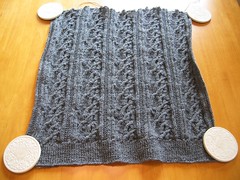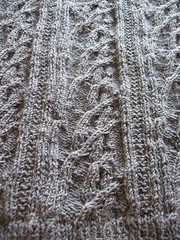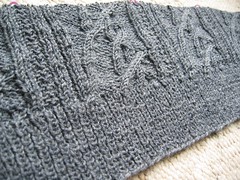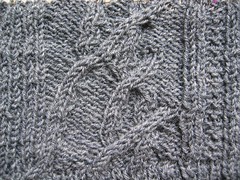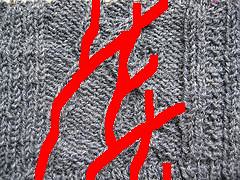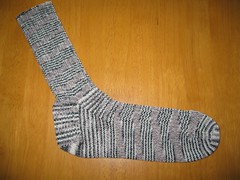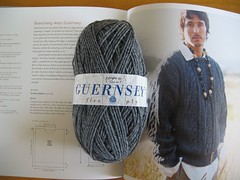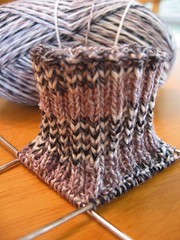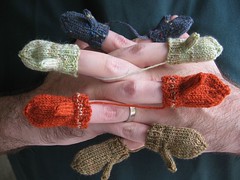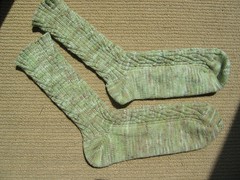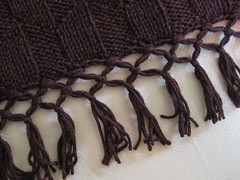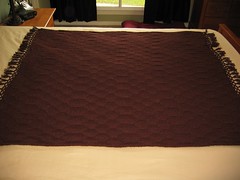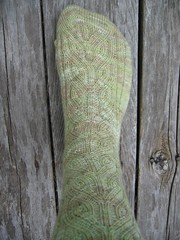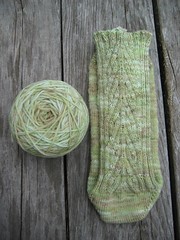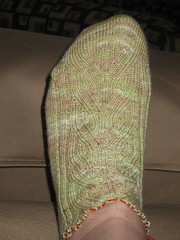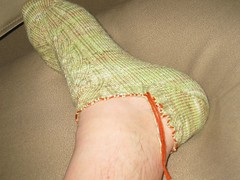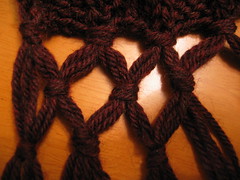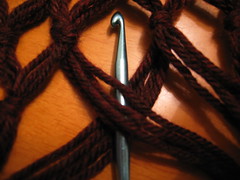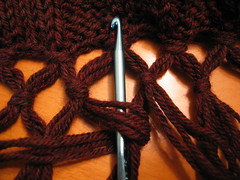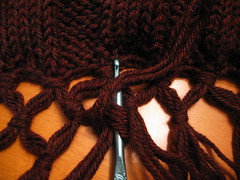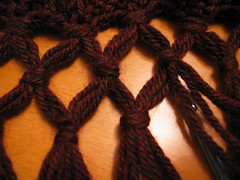Fans of the updated re-imagining of Battlestar Galactica will recognize the title of this post. Frack is a curse word from a galaxy far far away -- a five letter substitute for a four letter expletive with many letters in common, but one which can't be uttered on basic cable.
This word can also describe the first complete side of my Branching Aran Guernsey. I was under the impression, right up until the last six rows, that I was working on the front. Every other sweater pattern I've made (admittedly, only four -- and one of those was knit in the round), started with the front. But this one starts with the back. I was getting a little alarmed at how long it was growing before the neck and shoulder shaping, but I still didn't clue in until the last minute, due to an annoying process I resort to when I'm confused about a pattern.
Here's what I do. When I get confused, I have to read the pattern aloud to someone (Jeff) in hopes that verbalizing it will make the pattern make sense to me. In this case, I was confused about the decreases on the outside edges and on the neck edges. I had to diagram the directions I would be traveling with the two pieces of working yarn and talk the process through out loud. It doesn't seem to work in isolation -- I have to have someone present. Poor Jeff. He sits there patiently and nods at the right moments, even though he has little idea of what's going on. As usual, it worked -- I figured out how the decreases were supposed to work, and in the process realized that I was talking about the back instead of the front.
It's a little disturbing that I worked on this thing for a week and a half thinking I was on the front of the sweater. In fact, it's frackin' scary.
But on the other hand, I have the largest piece of the sweater done already. Everything else will be smaller. That's pretty frackin' awesome.
Monday, July 30, 2007
Friday, July 27, 2007
Celebrity Sighting
Last night, Jeff and I went to have dinner at a local eatery, the Kerbey Lane Cafe -- the one on South Lamar. We had just finished ordering and were leafing through copies of The Austin Chronicle, when I noticed that a woman in the booth across the way looked familiar...
It was none other than TV's Vickie Howell, knitting goddess and host of DIY's and HGTV's Knitty Gritty. How exciting! She was there with her husband and two sons. So I kind of gawked for a while, and then got embarrassed because I was gawking.
I waited until she finished her meal, and then politely approached her table, asked if she was Vickie Howell, and then introduced myself. I told her I loved her show and that it meant a lot to me because it started up about the time I started learning to knit. She was very gracious, saying thank you and introducing me to her family. I kept it short, and when they left they waved bye to me.
She was so incredibly nice. Like I knew she would be.
It was none other than TV's Vickie Howell, knitting goddess and host of DIY's and HGTV's Knitty Gritty. How exciting! She was there with her husband and two sons. So I kind of gawked for a while, and then got embarrassed because I was gawking.
I waited until she finished her meal, and then politely approached her table, asked if she was Vickie Howell, and then introduced myself. I told her I loved her show and that it meant a lot to me because it started up about the time I started learning to knit. She was very gracious, saying thank you and introducing me to her family. I kept it short, and when they left they waved bye to me.
She was so incredibly nice. Like I knew she would be.
Friday, July 20, 2007
Branching Out
I started work on the Branching Aran Guernsey a couple of days ago. I've found it kind of hard to stop...
This is a really interesting pattern, based on an algorithm. As the designer, Nora Guaghan writes, "every time a line splits into two branches, one continues on the same path as the original line and the second veers off at about a 30°angle." This might seem awfully complicated and at first glance it is, but I'm amazed at how fast it's been to knit.
First of all there are only four cable combinations in the pattern. One is used only 3 times in the 32-row repeats and another is used only once. One is quite easy to do without a cable needle. The fourth and most complicated cable stitch involves holding five stitches to the back, knitting two and then knitting and purling the five off the cable. I tried doing this without a cable -- it was possible, but because I knit tightly the stitches got stretched. I'm using the cable needle on that one now.
Secondly, there is basically just one 36-stitch line repeated five times with a little laddered stitch separating. Not so bad when compared with the Irish Moss sweater I started last summer. It had three different panel patterns to keep up with. Plus, it involved twisting stitches on both sides of the fabric. Funny thing about this -- it's been well over 9 months since I've worked on that sweater, and I still started knitting into the back of the stitches during the cabling automatically.
So while I may not be able to read the pattern as easily as the last Aran sweater I worked on, I still think this one is going to go faster.
Because the branching can be hard to decipher with my lousy photography, I marked up the picture above, outlining the paths of the branches. The overall effect will be more striking once a few more 32-row repeats are completed.
Oh -- and all of this was done with less than one ball of yarn. I'm still going to worry about whether I have enough (because that's how I roll), but things are lookin' good.
This is a really interesting pattern, based on an algorithm. As the designer, Nora Guaghan writes, "every time a line splits into two branches, one continues on the same path as the original line and the second veers off at about a 30°angle." This might seem awfully complicated and at first glance it is, but I'm amazed at how fast it's been to knit.
First of all there are only four cable combinations in the pattern. One is used only 3 times in the 32-row repeats and another is used only once. One is quite easy to do without a cable needle. The fourth and most complicated cable stitch involves holding five stitches to the back, knitting two and then knitting and purling the five off the cable. I tried doing this without a cable -- it was possible, but because I knit tightly the stitches got stretched. I'm using the cable needle on that one now.
Secondly, there is basically just one 36-stitch line repeated five times with a little laddered stitch separating. Not so bad when compared with the Irish Moss sweater I started last summer. It had three different panel patterns to keep up with. Plus, it involved twisting stitches on both sides of the fabric. Funny thing about this -- it's been well over 9 months since I've worked on that sweater, and I still started knitting into the back of the stitches during the cabling automatically.
So while I may not be able to read the pattern as easily as the last Aran sweater I worked on, I still think this one is going to go faster.
Because the branching can be hard to decipher with my lousy photography, I marked up the picture above, outlining the paths of the branches. The overall effect will be more striking once a few more 32-row repeats are completed.
Oh -- and all of this was done with less than one ball of yarn. I'm still going to worry about whether I have enough (because that's how I roll), but things are lookin' good.
Tuesday, July 17, 2007
The Chitin Runner
The first TOFUtsies Footsteps socks is done. In contrast to the fiber content, I'm decidedly un-crabby.
Well, maybe just a little crabby. This ball had a knot tied in it about 3/4 of the way down the foot of the sock. I hate this. Especially when the yarn is patterned. It threw off the striping a few rounds before the toe decrease. But otherwise, this stuff was fun to knit with. I went to Bluebonnet Yarn Shoppe yesterday to return some yarn I didn't need, and looked for some more of this yarn, but they only had really bright blues, purples, pinks and reds -- sorry, Jana -- I just couldn't do it!
Now, to cast on quickly before second-sock syndrome sets in.
The postman brought me some yarn today -- 12 skeins of Wendy Guernsey yarn in the color Shale. I got this online at a pretty good price. The pattern calls for 11 skeins, and this place had 12 left.
This pattern is going to be unusual for me, because I rarely use the yarn called for in patterns. It's always horribly expensive or a color I can't stand. But I really liked the look of this in the picture. This pattern is from Norah Gaughan's Knitting Nature, as was the Hex Afghan I finished a few weeks ago.
Why is it that many of the yarns used in widely-read knitting books disappear from circulation? Knowing that a well-publicized book with patterns featuring your yarns is about to come out, I would think that manufacturers would keep those lines available. But I have absolutely no grasp of the economics of yarn manufacturing. I should just be happy that I have the 12 skeins I need.
I'm going to need to do some serious swatching.. .
Well, maybe just a little crabby. This ball had a knot tied in it about 3/4 of the way down the foot of the sock. I hate this. Especially when the yarn is patterned. It threw off the striping a few rounds before the toe decrease. But otherwise, this stuff was fun to knit with. I went to Bluebonnet Yarn Shoppe yesterday to return some yarn I didn't need, and looked for some more of this yarn, but they only had really bright blues, purples, pinks and reds -- sorry, Jana -- I just couldn't do it!
Now, to cast on quickly before second-sock syndrome sets in.
The postman brought me some yarn today -- 12 skeins of Wendy Guernsey yarn in the color Shale. I got this online at a pretty good price. The pattern calls for 11 skeins, and this place had 12 left.
This pattern is going to be unusual for me, because I rarely use the yarn called for in patterns. It's always horribly expensive or a color I can't stand. But I really liked the look of this in the picture. This pattern is from Norah Gaughan's Knitting Nature, as was the Hex Afghan I finished a few weeks ago.
Why is it that many of the yarns used in widely-read knitting books disappear from circulation? Knowing that a well-publicized book with patterns featuring your yarns is about to come out, I would think that manufacturers would keep those lines available. But I have absolutely no grasp of the economics of yarn manufacturing. I should just be happy that I have the 12 skeins I need.
I'm going to need to do some serious swatching.. .
Saturday, July 14, 2007
I Got Crabs at My LYS
It's not as fun as it sounds -- but still pretty fun.
Yesterday, I took a field trip out to Bluebonnet Yarn Shoppe in Cedar Park. I've had a link to this place in my sidebar ever since I heard about it, but hadn't made the trek out to visit. I'm glad I did. The staff (whose names, of course, I didn't get) were friendly and helpful, asking about what I liked to knit and pointing me towards interesting stuff in their store. I bought some cotton yarn for a place mat idea that I had (doesn't look that's gonna work out), and three skeins of sock yarn, one of which is being turned into this sock.
This yarn is called TOFUtsies and I got the color Footsteps (737). It's made of an unholy union of superwash wool (50%), soy fibers (25%), cotton (22.5%) and chitin (2.5%). For the curious, chitin is the stuff of which shellfish exoskeletons are composed. This is supposed to make them tough. This likely also makes this the first non-kosher yarn I've ever knitted with. I'm not sure how this chitin is collected. The yarn is made in China, though, so I'm hoping poisoned crab chow wasn't involved in the process. All that aside, the chitin is supposed to make this yarn extra tough.
That may be, but for all its toughness this stuff is surprisingly soft. That's one of the things that attracted me to it. I was also attracted to the colors, which are kind of Burberry-like and remind me of some tube-socks I had as a kid. These were totally white with one black and one tan stripe near the top -- very 1960s.
I also wanted to try and knit outside my box. I wanted to try some new fibers from the usual superwash. This is a little strange to knit with -- kind of floppy is the way I'd describe it -- but still nice. The ball band called for knitting this on size 2 needles, and I even tried that. But I decided I wouldn't look good in fishnet socks. Seriously, there were holes you could stick a pencil through. Who knits socks like that? So I stepped back into my box with one foot and switched to good old size 0s. Much better.
Also, over the last few days, I've resurrected my project of knitting little mini-mittens out of the scraps of yarn left over from previous sock projects. My plan was to do this as I went along, but you know how that goes. These had been backing up for quite a while. You may recognize, from top to bottom, the yarns used in the Gentleman's Fancy Sock, the recently completed Vinnland Socks, the Gentleman's Sock in Railway Stitch, and the Cedar Socks.
Yesterday, I took a field trip out to Bluebonnet Yarn Shoppe in Cedar Park. I've had a link to this place in my sidebar ever since I heard about it, but hadn't made the trek out to visit. I'm glad I did. The staff (whose names, of course, I didn't get) were friendly and helpful, asking about what I liked to knit and pointing me towards interesting stuff in their store. I bought some cotton yarn for a place mat idea that I had (doesn't look that's gonna work out), and three skeins of sock yarn, one of which is being turned into this sock.
This yarn is called TOFUtsies and I got the color Footsteps (737). It's made of an unholy union of superwash wool (50%), soy fibers (25%), cotton (22.5%) and chitin (2.5%). For the curious, chitin is the stuff of which shellfish exoskeletons are composed. This is supposed to make them tough. This likely also makes this the first non-kosher yarn I've ever knitted with. I'm not sure how this chitin is collected. The yarn is made in China, though, so I'm hoping poisoned crab chow wasn't involved in the process. All that aside, the chitin is supposed to make this yarn extra tough.
That may be, but for all its toughness this stuff is surprisingly soft. That's one of the things that attracted me to it. I was also attracted to the colors, which are kind of Burberry-like and remind me of some tube-socks I had as a kid. These were totally white with one black and one tan stripe near the top -- very 1960s.
I also wanted to try and knit outside my box. I wanted to try some new fibers from the usual superwash. This is a little strange to knit with -- kind of floppy is the way I'd describe it -- but still nice. The ball band called for knitting this on size 2 needles, and I even tried that. But I decided I wouldn't look good in fishnet socks. Seriously, there were holes you could stick a pencil through. Who knits socks like that? So I stepped back into my box with one foot and switched to good old size 0s. Much better.
Also, over the last few days, I've resurrected my project of knitting little mini-mittens out of the scraps of yarn left over from previous sock projects. My plan was to do this as I went along, but you know how that goes. These had been backing up for quite a while. You may recognize, from top to bottom, the yarns used in the Gentleman's Fancy Sock, the recently completed Vinnland Socks, the Gentleman's Sock in Railway Stitch, and the Cedar Socks.
Wednesday, July 11, 2007
Vinnland Complete
I finished the second of the two Vinnland Socks today. In my typical, uneven, start-and-stop style, the whole pair took two months to make. Seven weeks to make the first one, one week to make the second. Special thanks to Julia for telling me that stitch chart had been corrected at the AntiCraft. I really thought I was going crazy, thinking that the "make one"-s and "make one purlwise"-es seemed to be quite random at the bottom of the stitch pattern. Once Julia pointed out that I was indeed not crazy (at least on this issue), I was soon on the way to having the pattern memorized.
I'd definitely recommend this pattern for those who want a challenging toe-up pattern. I did change it a little for myself, most notably using a wrap-stitch short row heel, rather than the short-row method outlined in the pattern, which called for a system using yarn overs. I did this out of laziness and fear -- I already knew how to do the wrap-stitch method, and I was freaked out about the complicatedness of the stitch pattern without wanting to worry about learning something else new. I sought a middle ground which made these do-able.
These socks were fun. They have a heavy, northern look to them. I think it's a combination of the vine-like pattern and the way the pattern weaves around both the front and the back of the sock. I also like how they appear cabled, but aren't.
And I like that I dyed the yarn myself.
I'd definitely recommend this pattern for those who want a challenging toe-up pattern. I did change it a little for myself, most notably using a wrap-stitch short row heel, rather than the short-row method outlined in the pattern, which called for a system using yarn overs. I did this out of laziness and fear -- I already knew how to do the wrap-stitch method, and I was freaked out about the complicatedness of the stitch pattern without wanting to worry about learning something else new. I sought a middle ground which made these do-able.
These socks were fun. They have a heavy, northern look to them. I think it's a combination of the vine-like pattern and the way the pattern weaves around both the front and the back of the sock. I also like how they appear cabled, but aren't.
And I like that I dyed the yarn myself.
Sunday, July 08, 2007
Fringe Benefits
My first-ever large blanket-sized project, the Hex Afghan, is complete!
I knuckled down his weekend to get this finished. I knew that working the fringe was a step that I could quite easily postpone indefinitely, so I made myself sit down and just do it. As mentioned in earlier posts, I'm not entirely sure this fringe is structurally stable, but there is small chance that little fingers will worry the edges, so I'm trying not to worry too much myself.
The edges are not as fuzzy as they are in the pictures of the original pattern, but the book called for knitting this in an alpaca blend that I didn't think would be very easy to care for. I was shooting for something a little more carefree, hence the superwash. This choice meant that the fringe was a little flat, but I'm glad I attempted it anyway -- it's a nice touch. And, if it ever gets too wonky, it can always be removed.
This was a fun project. Another one in which the 'stages' were uneven. Knitting the thing itself only took a few weeks. Doing the fringe took several more.
I'm pleased. The title is apt, I think -- it's composed of little hexagons and it is rather bewitching.
I knuckled down his weekend to get this finished. I knew that working the fringe was a step that I could quite easily postpone indefinitely, so I made myself sit down and just do it. As mentioned in earlier posts, I'm not entirely sure this fringe is structurally stable, but there is small chance that little fingers will worry the edges, so I'm trying not to worry too much myself.
The edges are not as fuzzy as they are in the pictures of the original pattern, but the book called for knitting this in an alpaca blend that I didn't think would be very easy to care for. I was shooting for something a little more carefree, hence the superwash. This choice meant that the fringe was a little flat, but I'm glad I attempted it anyway -- it's a nice touch. And, if it ever gets too wonky, it can always be removed.
This was a fun project. Another one in which the 'stages' were uneven. Knitting the thing itself only took a few weeks. Doing the fringe took several more.
I'm pleased. The title is apt, I think -- it's composed of little hexagons and it is rather bewitching.
Friday, July 06, 2007
The Anxiety of Freedom
I managed to finish the first Vinnland Sock today. I love it, I had fun, and most importantly of all -- it fits. I'm so much happier this time around and really glad that I stuck with it. I'm even starting to get the pattern semi-memorized so that I don't have to consult the pattern sheet quite so often.
I took this picture out on our deck this afternoon. Two things you should be aware of concerning this deck. First of all, it's dry. For the first time in two weeks. As of this writing, the last time it rained was 24 hours ago. We haven't gone 24 hours without rain in weeks, which is very freaky (as my niece and nephew would say) for this part of the world at this time of year. The second interesting fact about this deck is that it is slated to be replaced by a much safer and hopefully less rot-prone version. Can't wait for that.
One of the great things about toe-up socks is that you have the freedom to knit them as long as you want. With top-down socks, once you've turned the heel, you are committed on the length of the cuff. You're locked in. Not so with toe-up socks -- you just knit until you're happy with the length, you get tired of knitting, or you run out of yarn.
But this toe-up freedom breeds another problem: How do you know when to stop knitting the first one so that you have enough yarn left for the second one? Weighing the yarn would seem to be the answer. One of these days I'm going to get one of those really fancy electronic scales thatdrug dealers chemists use to weigh things by micrograms, so that I can split a ball of yarn exactly. But I don't have one -- just a kitchen scale that weighs ounces to the tenth of an ounce. It works okay, but it doesn't measure finely enough, and it doesn't do grams. I need something that does grams.
This time around I stopped knitting about where I wanted to. Actually, I wanted to stop earlier, thinking I had already used half the yarn, but I forced myself to keep knitting until the cuff was at least as long as the foot. I then tossed the sock onto my non-metric scale: 1.8 ozs. Would the remaining ball of yarn weigh more or less? I held my breath, put the ball on the scale, and breathed a sigh of relief: 1.9 ozs.
One of these days my luck will run out. But not today.
Oh, and I ordered some yarn today to make a sweater. For me. It's gonna be crazy cabley.
I took this picture out on our deck this afternoon. Two things you should be aware of concerning this deck. First of all, it's dry. For the first time in two weeks. As of this writing, the last time it rained was 24 hours ago. We haven't gone 24 hours without rain in weeks, which is very freaky (as my niece and nephew would say) for this part of the world at this time of year. The second interesting fact about this deck is that it is slated to be replaced by a much safer and hopefully less rot-prone version. Can't wait for that.
One of the great things about toe-up socks is that you have the freedom to knit them as long as you want. With top-down socks, once you've turned the heel, you are committed on the length of the cuff. You're locked in. Not so with toe-up socks -- you just knit until you're happy with the length, you get tired of knitting, or you run out of yarn.
But this toe-up freedom breeds another problem: How do you know when to stop knitting the first one so that you have enough yarn left for the second one? Weighing the yarn would seem to be the answer. One of these days I'm going to get one of those really fancy electronic scales that
This time around I stopped knitting about where I wanted to. Actually, I wanted to stop earlier, thinking I had already used half the yarn, but I forced myself to keep knitting until the cuff was at least as long as the foot. I then tossed the sock onto my non-metric scale: 1.8 ozs. Would the remaining ball of yarn weigh more or less? I held my breath, put the ball on the scale, and breathed a sigh of relief: 1.9 ozs.
One of these days my luck will run out. But not today.
Oh, and I ordered some yarn today to make a sweater. For me. It's gonna be crazy cabley.
Tuesday, July 03, 2007
Vinndication
I was right. I was having major gauge issues the first time around with the Vinnland Socks. I didn't post a picture of the ill-fitting mess I made a few weeks ago, but trust me, it was bad.
Repeat after me: Trust the pattern...trust the pattern...trust the pattern...
Here's a picture of my first Vinnland sock with the short-row heel just completed. The pattern covers 16 rows, and rather than stop at 4 pattern repeats before turning the heel, I did 4.5. The only thing I had to remember was to start the back of the calf on row 8. Yes -- once you get past the heel, the pattern is on the front and back of the sock. Good times!
I also had to do a little decrease on the left and right sides after the heel, so that the 2x2 ribbing pattern would continue correctly around the circumference of the sock.
I'm very pleased with how this is working. And, because I know everyone out there can't resist the charms of a well-turned cankle, here's a picture showing the short-row heel in a little more detail. The orange strand is just temporary, holding all the little stitches in place while the sock takes a short vacation from the needles.
Repeat after me: Trust the pattern...trust the pattern...trust the pattern...
Here's a picture of my first Vinnland sock with the short-row heel just completed. The pattern covers 16 rows, and rather than stop at 4 pattern repeats before turning the heel, I did 4.5. The only thing I had to remember was to start the back of the calf on row 8. Yes -- once you get past the heel, the pattern is on the front and back of the sock. Good times!
I also had to do a little decrease on the left and right sides after the heel, so that the 2x2 ribbing pattern would continue correctly around the circumference of the sock.
I'm very pleased with how this is working. And, because I know everyone out there can't resist the charms of a well-turned cankle, here's a picture showing the short-row heel in a little more detail. The orange strand is just temporary, holding all the little stitches in place while the sock takes a short vacation from the needles.
Sunday, July 01, 2007
The Lunatic Fringe
I managed to block the Hex Afghan yesterday. It turned out lovely. And now to the fringe.
The instructions in the pattern rather obliquely read "...knot Fringe as shown in diagram." I am then presented with a picture of knots. But not how to knot the knots. It appears the author either thinks this is very apparent or something that any knitter should have picked up years ago. I'm not one of those knitters.
I started by doing square knots. I didn't want them to slip. I even made little cardboard triangle and diamond-shaped space holders to knot the yarn around so that I could get some consistency. Unfortunately, the two ends didn't drape together after knotting. Rather, they stuck straight out, looking like little Pippi Longstockings.
So I undid them and found a web site with instructions on how to make knotted fringe. This is the method I decided to go with. I'm still not entirely happy, because one strand is being knotted around another, but the other strand is just there -- it's not incorporated into the knot. Hence, the knotted strand, unless pulled tightly, can slide up and down the other strand like a ring on a shower rod. But, it does allow all the strands to hang straight down after the knotting, so I'm going to go with it for now. And, surprisingly, I've been able to eyeball things enough to keep the knots in a nice little row. Let's hope that keeps up.
Here's what I'm doing -- illustrated with rather murky photographs.
Step 1.
The right-hand strands are stretched the left, the crochet hook placed over them, and then the left-hand strand are draped to the right.
Step 2.
All the work is done with the left-hand strands. Here they are pulled under both the right-hand strand and the crochet hook, and then pulled to the left.
Step 3.
Then, the strands are draped to the upper right and caught by the crochet hook to be pulled back through the loop that has been formed.
Step 4.
Finished!
I'm kind of flying by the seat of my pants here, folks, so if anyone wants to chime in before I get too committed to this method, please speak up. Until then, I've got to put in 80 strands of fringe, and make 320 knots...
The instructions in the pattern rather obliquely read "...knot Fringe as shown in diagram." I am then presented with a picture of knots. But not how to knot the knots. It appears the author either thinks this is very apparent or something that any knitter should have picked up years ago. I'm not one of those knitters.
I started by doing square knots. I didn't want them to slip. I even made little cardboard triangle and diamond-shaped space holders to knot the yarn around so that I could get some consistency. Unfortunately, the two ends didn't drape together after knotting. Rather, they stuck straight out, looking like little Pippi Longstockings.
So I undid them and found a web site with instructions on how to make knotted fringe. This is the method I decided to go with. I'm still not entirely happy, because one strand is being knotted around another, but the other strand is just there -- it's not incorporated into the knot. Hence, the knotted strand, unless pulled tightly, can slide up and down the other strand like a ring on a shower rod. But, it does allow all the strands to hang straight down after the knotting, so I'm going to go with it for now. And, surprisingly, I've been able to eyeball things enough to keep the knots in a nice little row. Let's hope that keeps up.
Here's what I'm doing -- illustrated with rather murky photographs.
Step 1.
The right-hand strands are stretched the left, the crochet hook placed over them, and then the left-hand strand are draped to the right.
Step 2.
All the work is done with the left-hand strands. Here they are pulled under both the right-hand strand and the crochet hook, and then pulled to the left.
Step 3.
Then, the strands are draped to the upper right and caught by the crochet hook to be pulled back through the loop that has been formed.
Step 4.
Finished!
I'm kind of flying by the seat of my pants here, folks, so if anyone wants to chime in before I get too committed to this method, please speak up. Until then, I've got to put in 80 strands of fringe, and make 320 knots...
Subscribe to:
Comments (Atom)
